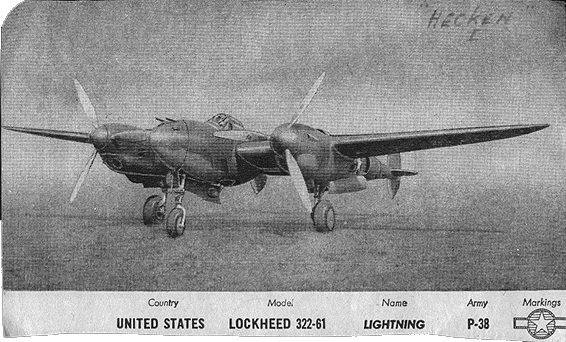9FS Unit History
1943 - Part 1
On 15 January, 1943, the 9th was equipped with P-38 Lockheed Lightnings. Pilots were sent to Townsville Australia to ferry the planes to New Guinea, and on 3 February the first mission was flown in P-38's. About March 1st, a flight or two were being staged out of Dobodura, New Guinea for local protection of ground forces. Weather was a big problem at this time, for Dobodura lay across a mountain range from Port Moresby, where the 9th had moved to 14 Mile Strip on 24 December (1942). Several new pilots were assigned to the 9th at this time, including Lt. Richard I. Bong. March 6, 1943, the Squadron moved to Dobodura, and the next day was in operation from the "Dobo" airstrip.
[c/o Warren Fowler scrapbook; actual image source unknown.]
DOBODURA, PAPUA NEW GUINEA
This airstrip, located about 10 miles inland from Buna on the edge of the rain forest, was the field from which the 9th operated for the longest period during the war. The dirt strip was 11,000 feet long, and was shared with 5th Bomber Command B-24's, B-25's, B-26's, the 9th squadron P-38's and the 7th squadron P-40's. For more than 4 months the 9th flew defensive missions; except for a few escort missions to Lae and Madang, we 'scrambled' as the Japs attacked shipping in nearby Oro Bay or Port Moresby across the mountains to our rear. Many 9th Aces earned their spurs here, among them being Richard I. Bong, James A. Watkins, Gerald R. Johnson, Grover E. Fanning, John G. O'Neill, John D. Landers and Ralph H. Wandrey. The Japs regularly bombed the airstrip and strafed the area several times. The 9th was plagued with a lack of planes, gas, ammunition and sometimes pilots. Occasionally we were told to fly around the mountains to avoid combat (due to lack of gas or ammo) and to return when the enemy aircraft had left the area. This kept our planes from being destroyed on the ground, and led the ground crews to refer to the "High altitude foxholes" the pilots "enjoyed"! A number of pilots were lost, some shot down and many others crashed due to bad weather. Some of the pilots lost at Dobo were: W. Bill Sells, Theron "Pappy" Price, Harold "Harry" Lidstrom, Francis Love, Stan Johnson, and George Haniotis. A few missions from this period hold special interest since they attest to the courage and stamina of 9th men under most adverse and trying conditions. On one occasion the 9th scrambled to intercept an unidentified number of aircraft reported heading for ships in Oro Bay. The squadron had one flight on patrol (led by Lt. Bong) which was low on gas and due to land. The remaining 12 planes on alert took off to intercept and Bong brought his flight in to refuel. The rest of the planes failed to make contact, and after a fruitless search returned to the field and landed. Then came word from ground control that a large flight of enemy aircraft was heading for Port Moresby. Bong's flight, which by now was refueled, took off and headed across the Owen Stanley mountains toward Port Moresby. One member of the flight aborted, but Lts. Dick Bong, Grover Fanning and Pete Alger continued and ground control became hysterical; there were over 100 Jap planes only minutes away from Moresby - headquarters of 5th Air Force. The three 9th pilots sighted about 75 Jap bombers escorted by 50 Zero fighters, and the bombers had begun their bombing run. Bong led his flight into the Zeros and pressed the attack through into the bomber formation. As he reported later, "We shot down a few fighters on our way to the bombers, and were able to split up the two lead flights enough to disrupt their bomb run. When I leveled out after the first pass, I was directly under the Jap formation and my plane was surrounded by falling bombs!"
The 3 men continued to attack until their ammunition ran out, and all three managed to return to Dobo. Their planes were riddled with bullet holes; Alger's craft had to be scrapped, and Bong had almost 200 holes in his plane. The Japs lost 3 bombers and 4 Zeros to our men, so the day was considered a success!
Another time the Japs attacked shipping in Oro Bay with a force of 45 bombers and 30 fighters. The 49th Group scrambled to intercept, and met the enemy about 10 miles out from Oro Bay. The 9th P-38's struck from above, driving the enemy formation down into the waiting 7th and 8th squadron's P-40's. In minutes the ocean was littered with burning planes; only one enemy bomber reached the edge of Oro Bay, dropping its bombs wide of the ships anchored there. There was only one enemy plane that escaped the 49th Group, and one of our bombers returning from a mission sighted the Jap about 80 miles out to sea and shot him down, thus accounting for the entire enemy force! This battle was not without cost to the 49th, as all three squadrons lost planes and pilots. A 9th pilot was sighted floating in his life vest surrounded by sharks. While some of our pilots circled and tried to guide an Australian rescue launch to him, shortly afterwards he disappeared. Lt. Thomas McGuire, at this time a 9th pilot, was shot down but was picked out of the ocean and sent to a hospital with broken bones and bruises suffered when he bailed out at low altitude. He later returned to combat, was assigned to the 13th Air Force and accounted for 38 enemy planes before he was killed in combat. Bong, Watkins, Wandrey, O'Neill and Price were some of the 9th pilots scoring 2 or more kills each in this battle.
Map of New Guinea and surrounding areas
(Image file size: 275kb mol)





